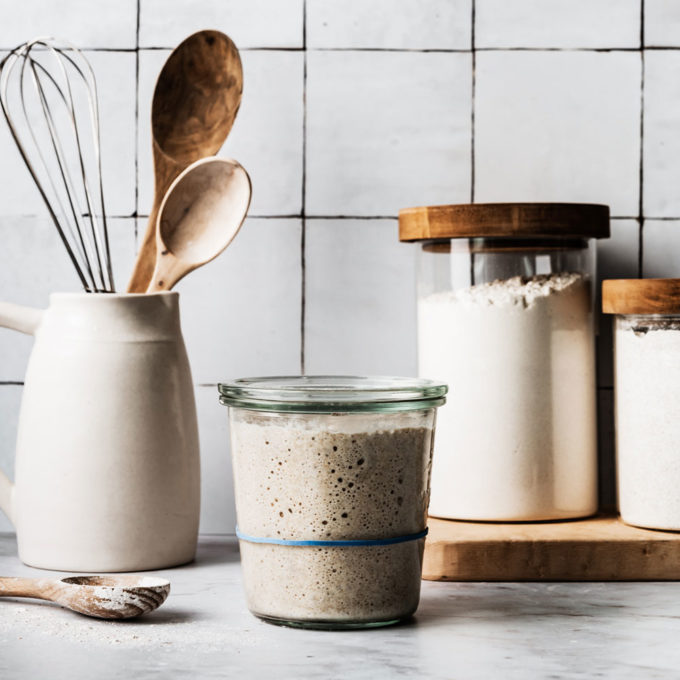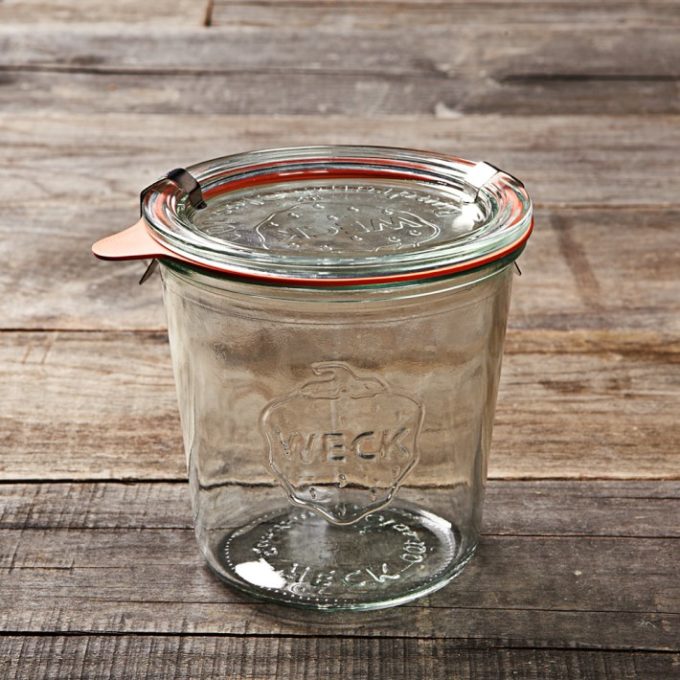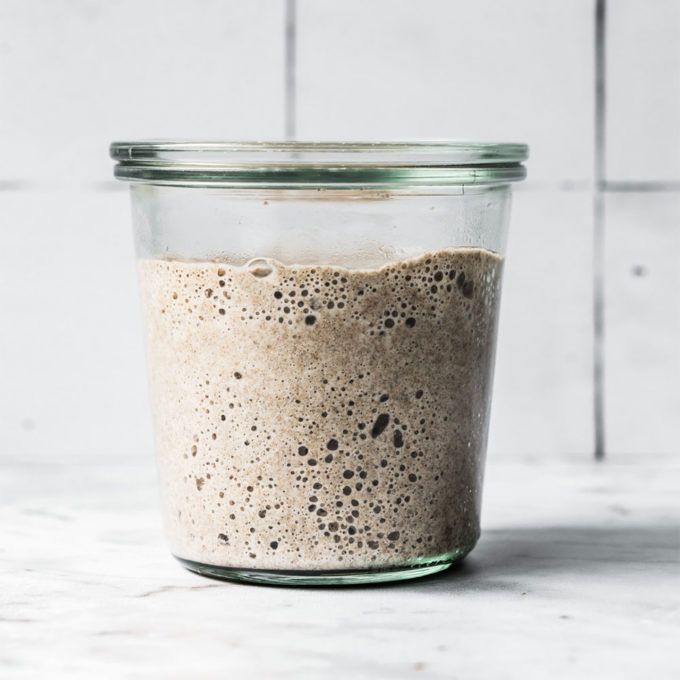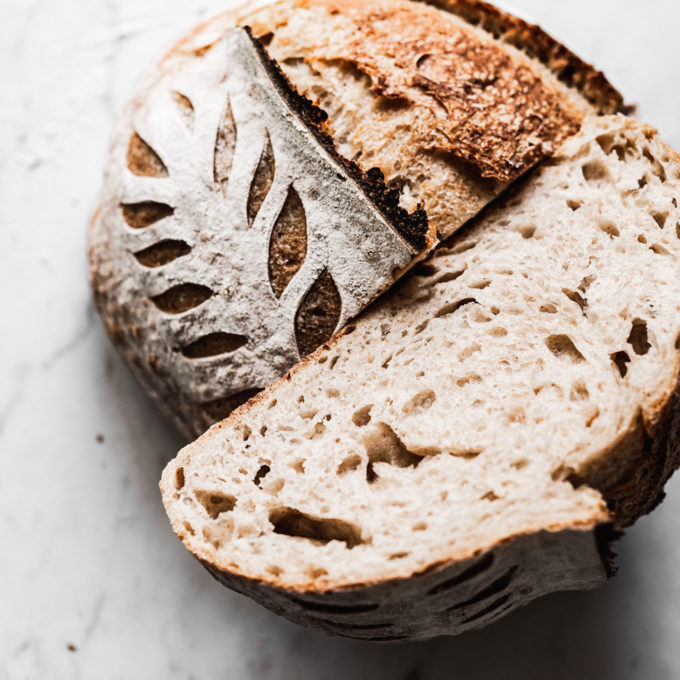
Last week on social media, we posted a popular step-by-step tutorial for how to make your own sourdough starter in seven days from Bella Karragiannidis of Ful-Filled. Bella starts with a blend of rye flour and filtered water, then provides a daily flour-and-water feeding regime which results in a bubbly bread-ready sourdough starter at the end of a week.
Ful-Filled’s sourdough starter post was a hit and many of you are ready to get going on building your own starter or have already begun! Since most of us are entirely new to sourdough starter technique, there have been some really good questions about the process. We asked Bella for the answers:
1. What do you do with the discard/excess starter? Is it still useable?
It takes time for a sourdough starter to strengthen enough, to contain enough yeast, to bake with. Baking with an immature starter will result in dense bread, or even bread that does not rise at all. The discard you end up with during the sourdough starter building process can be used to replace an equal weight or volume of flour and liquid in recipes for standard baked goods like crackers, pancakes, waffles or anything that includes additional leavening like baking soda or baking powder.
Once your sourdough starter is nice and active, there is no need to continue with daily feedings. Instead, you will store your starter in the refrigerator once it has reached peak activity. Keeping your sourdough starter in the refrigerator retards the fermentation process. When your sourdough starter is newer, we recommend pulling it from the refrigerator once a week to refresh it, typically you would do this the night before you are ready to make your sourdough baked goods.
Here is the feeding ratio we recommend to maintain a smaller amount of starter which eliminates discard/waste:
25g mature starter
25g stone-ground rye flour
25g unbleached all-purpose flour 50g warm filtered water (85°F)
***With this feeding ratio, at the end of seven days you will be left with about 100g of active starter to use in your sourdough baking and 25g of refreshed starter to store in your jar in the refrigerator.
2. What size jar is appropriate? Does it need to be sealed? Is glass better than ceramic?
Glass is the best choice for your sourdough starter jar as it allows you to monitor the activity and growth of your starter. Ideally, you would use a jar with a nice wide mouth to make stirring easy, with a capacity of 20-24oz. Weck jars are a great choice because they have glass lids that fit loosely but securely, allowing your sourdough starter to ‘breathe’ without drying out. Generally speaking, wide-mouth glass canning jars are a good choice.

3. Does it make a difference what kind of flour you use? Can I use all-purpose flour? What about whole wheat or bread flour?
Contrary to popular belief that the yeast in sourdough comes from the air, the primary initial source of sourdough microflora is actually from the flour. Yeast and bacteria live on the outside of the grain (just like the yeast to make wine lives on the skin of the grapes). Whole-grain rye flour is so great for sourdough because it has a high level of enzymes that attract a variety of yeasts.
Using whole-grain rye flour when creating a starter helps speed up the process. You can certainly use whole wheat flour or even all-purpose flour if you’d like, but we find rye flour to be the most effective flour at the beginning. If you don’t have rye flour, then whole wheat or spelt is better than white (sifted) flours like all-purpose or bread flour.
4. Why keep feeding it so much? Why not use it after 24 hours? Do you have to wait the 7 days to start baking with it?
In the first few days of building a sourdough starter, you will most likely see lots of bubbles and activity. This initial activity may suddenly stop and make it seem like something has gone wrong. This initial burst of activity is typically a different type of bacteria in your starter that will eventually be replaced by the kind of bacteria we are trying to foster in our starter (lactic acid bacteria).
As you continue feeding and discarding your starter, it will slowly become more and more acidic. The other bacteria that might be present die off, which allows the beneficial yeast and bacteria we are looking for to take over and create an active sourdough starter that is strong enough to leaven all manner of baked goods!

5. If my starter is not showing activity or has decreased, do you recommend starting over? What if it has not been showing rise after 3 or 5 days?
As mentioned above, initial activity in the first few days may suddenly stop and make it seem like something has gone wrong. Be patient. If you have followed the daily feeding regime, you should start noticing increased activity as you continue feeding.
To ensure success, one factor to consider is temperature: your sourdough starter will thrive if it is kept at a warmer ambient temperature (76-82°F). Cold temperatures will slow down fermentation, whereas warmer temperatures will speed up the sourdough building process. Try to find a warm place to keep your starter like in your oven with the light on or set on a heating pad on the lowest setting (use a thermometer to monitor and regulate the ambient temperature where you keep your starter).
6. How long does it last without being used and how do you reactivate it?
Once your starter is active, it is best to store it in the refrigerator when you are not baking. Especially when your sourdough starter is young, it is good to feed it once a week, but the more mature it is, the longer you can leave it in the refrigerator before feeding again. Starters have been known to be left for 10 days, 2 weeks, 1 month (or even longer) with no issue of coming back to full activity! Of course, after a long feeding hiatus, you want to make sure that your starter is reaching peak activity before you bake with it (this may mean that you have to perform some additional feedings before baking with it).
Follow this link for the Sourdough Starter Guide from Ful-Filled.


3 comments
When I bake loaves of bread, I am getting a lacey texture at the edge of the loaf but the middle remains a tighter structure. I am using a 6.5 qt Dutch Oven. Should I use a smaller Dutch over or a larger dutch oven?
When doing a weekly maintenance feeding of starter with no plans to bake that week, do you feed and put back in the refrigerator right away, or do you leave it sit on counter overnight, discard all but 25 g in the am and leave for another week?
[…] most frequently asked sourdough starter questions and have answered all of them over on their blog! CLICK HERE to read the SOURDOUGH STARTER […]